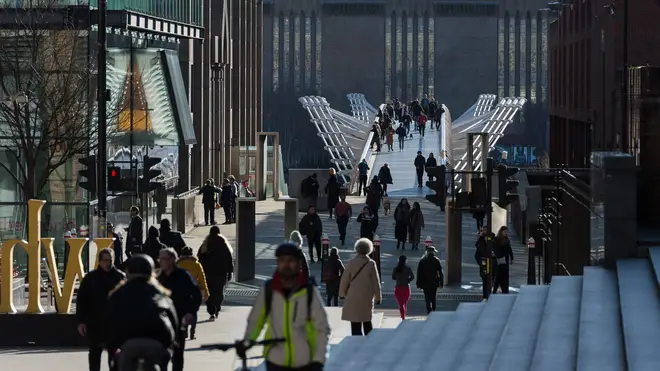
Nick Abbot 10pm - 1am
15 February 2021, 14:30 | Updated: 15 February 2021, 17:19

Coronavirus case rates have fallen across nearly 95 per cent of local authorities in the UK, new figures show.
Of the 380 local authorities areas across the UK, only 23 (6 per cent) have seen a week-on-week increase in case rates compared with 354 (93 per cent) where the rates have fallen.
The highest case rate in the UK was in Corby, Northamptonshire, with 277 new cases recorded in the seven days to February 10 - the equivalent of 383.6 cases per 100,000 people.
This was down from 468.0 cases per 100,000 people in the seven days to February 3.
The figures, for the seven days to February 10, are based on tests carried out in laboratories (pillar one of the Government's testing programme) and in the wider community (pillar two).
The rate is expressed as the number of new cases per 100,000 people.

Boris Johnson: Roadmap out of lockdown will include key dates
Boris Johnson hailed the achievement - just over two months after the vaccination programme delivered its first jab - as a "significant milestone" in the fight against the disease.
The Prime Minister confirmed on Sunday that it had been met in England after First Minister Mark Drakeford announced on Friday that Wales had become the first of the four nations to reach it.
There are reports today that as ministers are discussing plans to allow some shops to re-open, families to meet again and self-catering staycations to be allowed if Covid-19 infection rates continue to fall.
The passing of the 15 million vaccinations mark paves the way for the next phase of the the rollout - covering the next five priority groups, including the over 50s -to begin.
NHS England has already sent out 1.2 million invitations to the over 65s to book an appointment, with a similar number expected to go out this week.
The Government is aiming to get an offer of a vaccine to the estimated 17 million people in the next five groups by the end of April.

James O'Brien reacts to lockdown roadmap announcement
- England
Of the 315 local areas in England, 12 (4%) have seen a rise in case rates, 301 (95%) have seen a fall, and two are unchanged.
The highest week-on-week increase in England was in Copeland, Cumbria, where the rate has risen from 177.5 to 237.6, with 162 new cases.
Calderdale in West Yorkshire had the second highest rise, up from 164.1 to 207.1, with 438 new cases.
Newark and Sherwood in Nottinghamshire had the third highest, up from 213.2 to 248.3, with 304 new cases.
- Scotland
Of the 32 local areas in Scotland, eight (25%) have seen a week-on-week rise in case rates, while 24 (75%) have seen a fall.
East Ayrshire had the highest rate in the country, up from 154.9 to 252.4, with 308 new cases.
This was followed by Clackmannanshire, which was up from 163.0 to 221.2, with 114 new cases.
Stirling had the third highest rise, up from 130.6 to 159.2, with 150 new cases.
- Wales
Of the 22 local areas in Wales, three (14%) have seen a rise in case rates, 18 (82%) a fall, and one has remained the same.
Wrexham had the highest rate in Wales, down from 229.5 to 161.1, with 219 new cases.
The three areas recording a week-on-week rise were:
- Powys (up from 84.6 to 120.1, with 159 new cases)
- Conwy (up from 110.9 to 113.5, with 133 new cases)
- Cardiff (up from 100.0 to 100.6, with 369 new cases)
- Northern Ireland
All of the 11 local areas in Northern Ireland have seen a drop in case rates.
The highest rate was in Mid Ulster, which was down from 301.6 in the week to February 3 to 234.3 in the seven days to February 10, with 348 new cases.
The biggest drops was in Armagh City, Banbridge and Craigavon, where the rate fell from 283.1 to 207.2, with 448 new cases.
Here is the list of the 23 areas where rates have increased week on week.
From left to right, it reads: name of local authority; rate of new cases in the seven days to February 10; number (in brackets) of new cases recorded in the seven days to February 10; rate of new cases in the seven days to February 3; number (in brackets) of new cases recorded in the seven days to February 3.
Fenland, 282.8, (288), 261.2, (266)
Bolton, 276.1, (794), 274.7, (790)
East Ayrshire, 252.4, (308), 154.9, (189)
Newark and Sherwood, 248.3, (304), 213.2, (261)
Copeland, 237.6, (162), 177.5, (121)
Bradford, 221.6, (1196), 218.4, (1179)
Clackmannanshire, 221.2, (114), 163.0, (84)
North Warwickshire, 213.0, (139), 211.4, (138)
Calderdale, 207.1, (438), 164.1, (347)
Kingston upon Hull, City of, 172.5, (448), 150.1, (390)
Stirling, 159.2, (150), 130.6, (123)
Powys, 120.1, (159), 84.6, (112)
Conwy, 113.5, (133), 110.9, (130)
Mole Valley, 112.3, (98), 111.2, (97)
Cardiff, 100.6, (369), 100.0, (367)
Dumfries and Galloway, 100.1, (149), 96.1, (143)
Midlothian, 99.5, (92), 91.9, (85)
Highland, 62.3, (147), 57.2, (135)
Exeter, 51.0, (67), 36.5, (48)
Orkney Islands, 26.9, (6), 4.5, (1)
North Devon, 26.8, (26), 25.7, (25)
Torridge, 17.6, (12), 14.6, (10)
Shetland Islands, 8.7, (2), 0.0, (0)